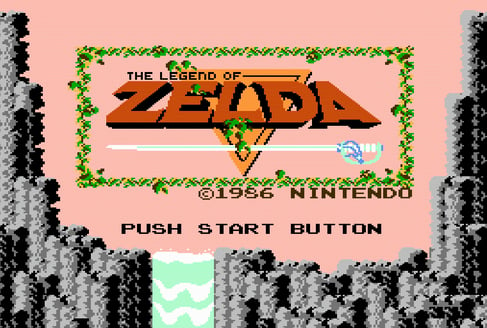Puzzles are a staple of adventure and role-playing games. However, the design for a puzzle dungeon presents not-so-typical challenges. Fortunately, Torchbearer has systems, tactics, and mechanics that can help create an enjoyable and challenging puzzle dungeon experience.
What is a Puzzle Dungeon?
A puzzle dungeon is not just a "dungeon with puzzles." A puzzle dungeon combines the "getting to the end" element from a gauntlet design and the "non-linear exploration" element from a labyrinth design. A puzzle dungeon requires ingenuity from the players to solve and more-than-usual planning and preparation from the GM to pull off successfully. A puzzle dungeon funnels all actions to the point where something must be "solved."
Overcoming puzzle obstacles demands something that is not obvious, not readily available, or not totally within the party's current capabilities to proceed. The group might need to find a hidden key, obtain the words to complete the ritual, or discover the answer to some sequence before getting the reward. All Torchbearer dungeons have some of these elements, but a puzzle dungeon is a particular design that involves logic, patterns, sequences, or order. Overcoming a series of obstacles is necessary to activate something else in the puzzle dungeon's culminating finale.
Sample Puzzle Obstacles
- Pull the levers in sequence
- Unlock the door using the unique key
- Arrange spectral goblets on the mead hall table
- Solve the troll's riddle
- Touch the sigils in different orders to open various magical portals
- Activate the floor panels to reveal the stairs
- Deduce the proper sacrifice to appease the Immortal Lord
- Assembling a gnomish machine with missing parts
- Escort the golem through the dungeon by clearing obstacles
We'll look at drawing inspiration from the classic action-adventure game Legend of Zelda as a point of reference to think about puzzle dungeons. Zelda gets a lot of puzzles right by keeping the solutions intuitive and straightforward in a cohesive quest to find the shards of the Triforce, the Ultimate Power.
The Triforce of Knowledge
The first tool in the GM toolkit for puzzle dungeons is knowledge. Puzzle dungeons can become frustrating is the players feel like they "don't know what to do." The players should have agency at every step of the way, and there should not be some linear script the party must follow to get to the end.
Theme
For best results, a cohesive idea connects the various puzzles into something meaningful. "The Eagle" is the theme of the first level of Zelda. The layout forms the shape of a majestic bird.
Knowledge of the theme could help the party solve a puzzle by providing a clue to the solution. In the Eagle dungeon, the Wizard gives a clue that a secret is in the "eastmost" wing.
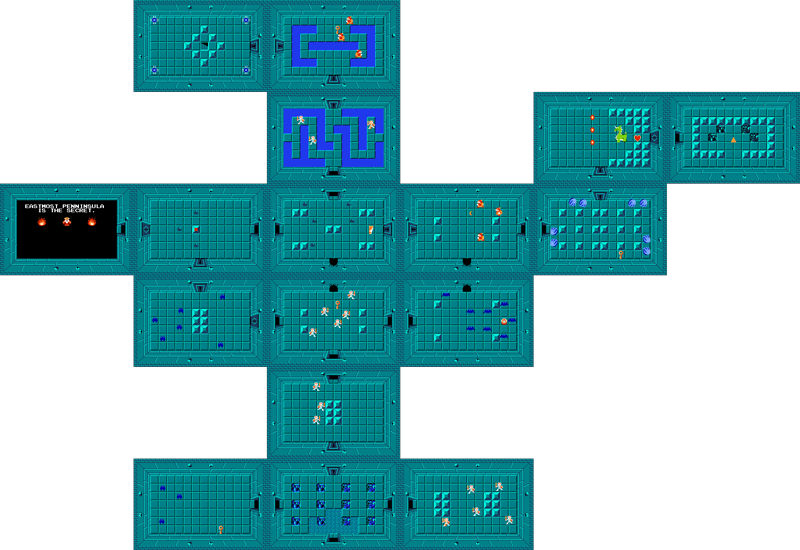 The theme is simple, elegant, and something that aids the GM's initial plans and design. The theme could be a motif that is carried throughout the dungeon. For example, the facade or walls could be carved with reliefs of eagles. Scavengers could find feathers and twigs from nests. Lore Masters could recall stories of ancient peoples that worshiped eagles.
The theme is simple, elegant, and something that aids the GM's initial plans and design. The theme could be a motif that is carried throughout the dungeon. For example, the facade or walls could be carved with reliefs of eagles. Scavengers could find feathers and twigs from nests. Lore Masters could recall stories of ancient peoples that worshiped eagles.
Building an Adventure
Now that you have a design subject, follow the Building an Adventure design guidelines (Torchbearer, p.123). Resume here when you get to step eight (What traps or terrain features make navigating the adventure location difficult?).
Multiple Clues and Multiple Solutions
Always keep puzzle dungeons simple, but the trick is balancing the unknown. Zelda puts clues and keys in multiple places. Place "knowledge" loot (lore, solutions to traps, clues to secrets) behind a different obstacles and areas.
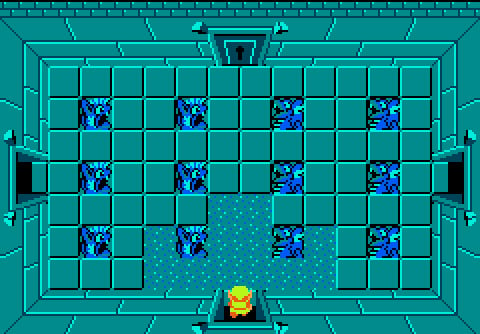 A locked door is the first obstacle in the first area of the Eagle dungeon. Link can find a key from the bats in the left room or the skeleton Stalfos in the right room.
A locked door is the first obstacle in the first area of the Eagle dungeon. Link can find a key from the bats in the left room or the skeleton Stalfos in the right room.
Customizing the Dungeon
Knowing what Wandering Monsters and Twists to throw at a group will often make or break a puzzle dungeon. Preparing creature lists and unique twists really helps to keep the excitement going in the dungeon.
Some GMs focus on creating the perfect puzzle and forget to engage the players. Knowing what your players want and modifying the dungeon to challenge the players' beliefs or goals is another way to amp up a dungeon. Yes, the players are responsible for creating their beliefs and goals, but the GM has the responsibility to listen to the players and adapt. When setting goals and beliefs, the players are telling the GM what they want to do, so the GM should check that the obstacles challenge those beliefs and goals. Create situations that continuously challenge beliefs. Would a character play against a belief to get the ammo for the catapult to break through the wall?
Using Gear
Knowledge of what gear to bring can add to the suspense of the dungeon. In town, characters can learn information from the Tavern, Shrine, Friends, or Personal Business. Use foreshadowing and clues to suggest different items to bring. Mirrors, garlic, and oil are always multi-purpose items that can double as supplies to solve a puzzle.
The Loot Carrot
Give the players knowledge of the risk and reward. Let the party see the fabled sword atop the mountain guarded by foreboding statues. Give them a clear view of the target destination.
One thing Zelda gets right is generous loot. In a puzzle dungeon, there should be a wealthy treasure distribution. Create custom loot tables. Place loot like breadcrumbs to reward exploration. After defeating a puzzle obstacle, always give the party some loot. However, remember not every area of the dungeon has great treasure and not all loot is necessarily valuable.
The Triforce of Failure
Puzzle dungeons can be tedious if the GM railroads the players through the dungeon. Plan to keep the group immersed and focused on "describing forward" and by providing choices for the group at all times.
Failing Forward!
When addressing the issue of pacing in a puzzle dungeon, the most versatile tool in your GM toolkit is Failing Forward (Torchbearer, p.118). The characters are not heroes that are meant figure it all out. Use this to your advantage and plan accordingly. Whereas traditional RPGs can get bogged down in re-rolls and repetitive actions in an attempt to solve the puzzle "correctly," Torchbearer has a built-in failure mechanism to keep the game moving. Don't let the players plow through locked doors or skate through ponderous riddles. Instead, plan for failure and come up with a list of twists that close off one avenue but present another. Some GMs find it helpful to use flow charts to plot these choices.
Breaking Parts
One way to make a puzzle fun is to progress the situation in the dungeon through breaking stuff. Maybe some piece of gnomish machinery could be fixed with some missing parts, but a well-intended but bumbling adventurer breaks the machine. Now what? Plan for failure. Maybe an enemy faction offers to become allies now that you have advanced their agenda. This could lead to a situation that is ripe for an alignment shift or a changing belief in subsequent sessions.
Leaving the Dungeon
In Zelda, Link can leave the dungeon at any time and that provides a much-needed pressure valve. In Torchbearer, a Cartographer can use a map to fast travel out of the dungeon if they have successfully mapped all of the areas and can recount them verbally. In many Torchbearer adventures, the party might choose to leave the dungeon to return later or never again. Don't assume the players will "get to the end" or even want to "finish the puzzle." Design your puzzle dungeon to provide fulfilling milestones and fun and memorable checkpoints along the way.
The Triforce of Ingenuity
Everyone enjoys a good puzzle. Working together to solve something is incredibly rewarding. Torchbearer rewards creativity and a puzzle dungeon should too.
Creative Natures
A big challenge in a puzzle dungeon is that the players and characters know different things. An immortal elf that has lived a dozen human lifetimes and can remember the Dawn of Law might possess an almost god-like level of ingenuity. Although an elf acts as a scholar recalling parts of history, don't let elves remember a way through every puzzle. Also, there could be a severe risk for such remembering: tragedy and grief can lead to psychological twists or the Angry or Afraid condition. However, using Nature to overcome puzzles can be particularly rewarding. Check out the Boasting rules (Middarmark, p.79) for ideas of how to reap tremendous glory after completing a puzzle dungeon.
Boss Battles
Boss Battles are an excellent opportunity for clever solutions and cunning tactics.
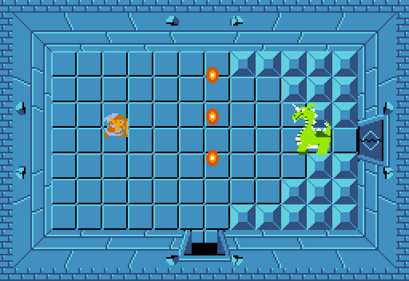
In the Eagle dungeon, Aquamentus, the dragon, guards the Triforce. Dragons are serious business in Torchbearer. So you can create puzzles that affect the boss battle to adjust the difficulty. If the party solves some puzzle, they are rewarded with something that nullifies a boss weapon or perhaps takes out some minions. Something impossible becomes possible through ingenuity.
Custom Puzzle Conflicts
The abstraction of Torchbearer conflicts affords the GM to create puzzles as "Other" conflicts where the GM sets the Ability and Skills appropriate for the puzzle. Puzzle conflicts are best when completing a series of actions.
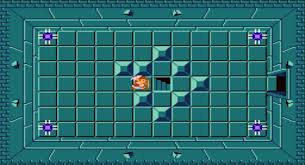
In the Eagle dungeon, you could run the blade trap room as a conflict.Link must avoid blade traps, push a column away to reveal the stairs, climb down the ladder, and dodge some bats.
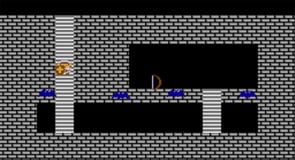
Getting to the bow becomes the goal of the conflict. Blade traps, the heavy column, and stalking monsters are the conflict weapons. For Abilities and Skills, you could use Dungeoneer and Health for the conflict. If the party wins, they get the bow. If they lose, they are thwarted and driven back out of the room.
For cognitive puzzles, you could run a puzzle conflict using Scholar and Will. You can get crazy and make all sorts of puzzle conflicts, like one that uses Criminal and Steward to snatch coins and to stack them in evenly distributed piles. When creating "other" conflicts, list out some conflict weapons for players too (see 'Improvised Weapons,' Torchbearer, p.121) and place them as loot throughout the dungeon.
Just as a dungeon is more than the sum of its obstacles, a puzzle dungeon is more than its gimmicks. If designed well, a puzzle dungeon can create an immersive and unique adventure that challenges both players and GM.
Game on,
Koch
"Link" © 2014 xercity. CC-BY 4.0
"Opening Zelda" by Ali Mohammed CC BY-SA 3.0

